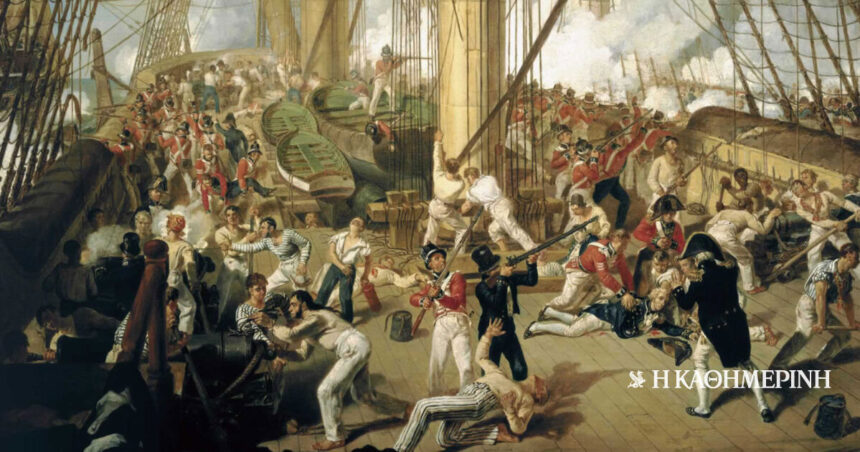“England expects every man to do his duty.” That was the message sent by the vice admiral Horace Nelsonhead of the British forces just before the start of the Battle of Trafalgaron 21 October 1805. Britain’s Royal Navy was to face the combined Franco-Spanish fleet off the coast of Cape Trafalgar, in south-west Spain, in a pivotal moment in the Napoleonic Wars which established Britain’s supremacy at sea and ended hopes of of Napoleon to invade the country. Although the British fleet was greatly outnumbered, Nelson’s bold tactics, including his famous strategy of breaking the enemy line, broke the French resistance. This victory did not come without a heavy price: Nelson himself was mortally wounded and passed forever into the judgment of History.
France was trying to control European waters and facilitate a possible invasion of Britain.
The stakes at Trafalgar were high as Napoleonic France sought to control European waters and facilitate a possible invasion of Britain. The French fleet, under Admiral Pierre-Charles Villeneuve, had started from Toulon and, hoping to avoid the British blockade, intended to join other French ships. After several skirmishes, he managed to break the British blockade and sailed to Cadiz, Spain, in order to join the Spanish navy, with the aim of gaining sovereignty in the English Channel. Britain’s concern that if the Franco-Spanish fleet dominated the seas, Napoleon’s troops could pass unmolested into Britain was reasonable. In this sense, Trafalgar was not just a naval battle, but a struggle for Britain’s survival as a dominant power.
Indeed, in August 1805 Villeneuve’s ships reached Cádiz, which Nelson’s fleet had blockaded for weeks, constantly putting pressure on the Franco-Spanish forces. Villeneuve, under pressure from Napoleon and despite his objections, finally sailed from the port, leading to the fateful meeting.
Nelson split his fleet into two divisions and attacked vertically – an unorthodox approach that took the enemy by surprise.
The strategic acumen Nelson displayed off Trafalgar was evident from the start. Instead of using the traditional tactic of having the ships line up in parallel lines, he split his fleet into two sections and attacked vertically – an unorthodox approach that took the enemy by surprise. This maneuver effectively broke the Franco-Spanish line, weakening its numerical advantage. The ensuing chaos allowed the British to isolate and defeat individual ships, breaking up the cohesion of the enemy fleet.
The naval battle was fierce. By the time Nelson’s flagship, HMS Victory, encountered Villeneuve’s Bucentaure, the decks of both ships were littered with debris, dead and wounded from enemy artillery fire. The British side’s gunpower and ship handling were superior to the Franco-Spanish fleet, leading to a devastating defeat for Napoleon’s forces. Of the 33 enemy ships, 22 were captured or destroyed, while the British lost none, a testament to Nelson’s seamanship and inspired command.
During the naval battle, the British admiral was shot by a French sniper.
The Battle of Trafalgar, however, was to be an even more important milestone in his life. During the naval battle, the British admiral was shot by a French sniper. The bullet went through the left shoulder, the lung and lodged in his spine. Badly wounded, he was taken to the ship’s infirmary, where he told surgeon William Beatty: “There’s not much you can do for me, doctor.” At 16:30 Horace Nelson breathed his last. Despite his mortal wound, he lived long enough to learn of the victory, which secured his legacy as a national hero: his death turned Trafalgar not only into a strategic triumph but also into a symbol of personal sacrifice for the nation.
The effects of the naval battle were very significant. While the immediate effect was the destruction of Napoleon’s plans to invade Britain, the long-term impact cemented British naval supremacy for more than a century, reshaping the geopolitical balance. Control of the seas allowed Britain to build a global empire, extending its influence from India to the Americas. Instead, Napoleon turned his attention to continental Europe, leading a series of land campaigns that would define the latter part of his reign.
Trafalgar is often seen as the final nail in the coffin of French naval ambitions.
In historical analysis, Trafalgar is often seen as the final nail in the coffin of French naval ambitions. According to modern interpretations, the outcome of the naval battle was not just about the numbers or strength of the ships involved, but about strategic foresight and leadership. Nelson’s leadership, bold and decisive, was the key to overcoming the numerical superiority of the Franco-Spanish fleet. His willingness to employ high-risk tactics demonstrated a broader shift in naval warfare, where mobility and surprise became key ingredients for success.
Nelson’s legacy, immortalized in monuments such as Nelson’s Column in London’s Trafalgar Square, continues to inspire admiration for his leadership, while the battle itself remains a textbook on naval strategy and courage under heavy enemy fire. .
Column editor: Myrto Katsigera, Vassilis Minakakis, Antigoni-Despina Poimenidou, Athanasios Syroplakis




